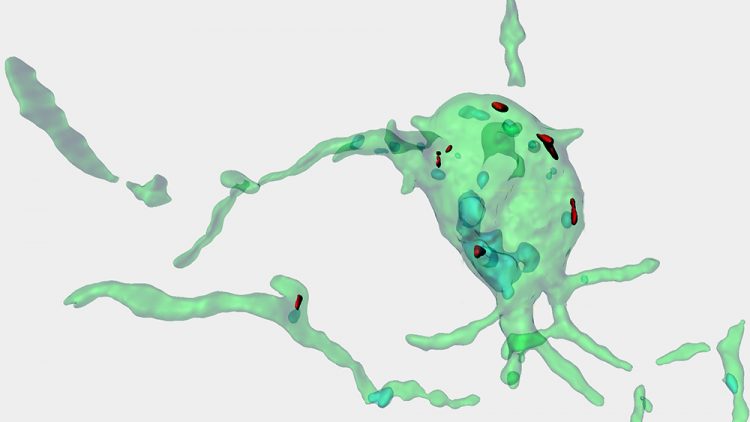Overactive Scavenger Cells May Cause Neurodegeneration in Alzheimer's

Microglia cell with phagocytic structure (in cyan) containing synaptic proteins (in red). (Image: UZH)
Similar to other neurodegenerative disorders, Alzheimer's is a disease in which the cognitive abilities of afflicted persons continuously worsen. The reason is the increasing loss of synapses, the contact points of the neurons, in the brain. In the case of Alzheimer's, certain protein fragments, the β-amyloid peptides, are suspected of causing the death of neurons. These protein fragments clump together and form the disease's characteristic plaques.
Voracious microglia cells destroy brain synapses
Together with researchers from Great Britain and the United States, the group of Lawrence Rajendran from the Institute for Regenerative Medicine of the University of Zurich now shows that dysfunctional microglia cells contribute to the loss of synapses in Alzheimer's and other neurodegenerative diseases. These scavenger cells usually monitor the function of neurons in the brain by removing excess synapses during development or toxic protein aggregates. Until now, their role in neurodegenerative disorders remains controversial.
In an initial step, the researchers looked at the effect that certain risk genes for Alzheimer's have on the production of the β-amyloid peptide. They found no effect in neurons. This led the researchers then to examine the function of these risk genes in microglia cells – and made a discovery: If they turned off the gene for the TDP-43 protein in these scavenger cells, these cells remove β-amyloid very efficiently. This is due to the fact that the lack of TDP-43 protein in microglia led to an increased scavenging activity, called phagocytosis.
The TDP-43 protein regulates the activity of scavenger cells
In the next step, researchers used mice, which acted as a disease model for Alzheimer's. In this case, as well, they switched off TDP-43 in microglia and observed once more that the cells efficiently eliminated the β-amyloid. Surprisingly, the increased scavenging activity of microglia in mice led also to a significant loss of synapses at the same time. This synapse loss occurred even in mice that do not produce human amyloid. This finding that increased phagocytosis of microglia can induce synapse loss led researchers to hypothesize that perhaps, during aging, dysfunctional microglia could display aberrant phagocytic activity. “Nutrient deprivation or starvation-like mechanism during aging could enhance phagocytic mechanism in microglia and this could lead to synaptic loss” Lawrence Rajendran assumes.
Direct role in neurodegeneration
The results show that the role of microglia cells in neurodegenerative diseases like Alzheimer's has been underestimated. It is not limited to influencing the course of the disease through inflammatory reactions and the release of neurotoxic molecules as previously assumed. Instead, this study shows that they can actively induce neurodegeneration. “Dysfunction of the microglia cells may be an important reason why many Alzheimer's medications reduce the amyloid plaques in clinical testing, but the cognitive functions in patients do not lead to improvement,” Rajendran says.
This work was supported by the Swiss National Science Foundation, Velux Foundation, Synapsis Foundation, Cure Alzheimer Fund and the Forschungskredit of the University of Zurich.
Literature:
Rosa C. Paolicelli, Ali Jawaid, Christopher M. Henstridge, Andrea Valeri, Mario Merlini, John L. Robinson, Edward B. Lee, Jamie Rose, Stanley Appel, Virginia M.-Y. Lee, John Q. Trojanowski, Tara Spires-Jones, Paul E. Schulz, and Lawrence Rajendran. TDP-43 Depletion in Microglia Promotes Amyloid Clearance but Also Induces Synapse Loss. Neuron. 29 June 2017; doi:1016/j.neuron.2017.05.037
Contact:
Prof. Lawrence Rajendran, PhD
Institute for Regenerative Medicine
University of Zurich
Phone: +41 44 634 88 60
E-mail: lawrence.rajendran@irem.uzh.ch
http://www.media.uzh.ch/en/Press-Releases/2017/microglia-Alzheimers.html
Media Contact
All latest news from the category: Life Sciences and Chemistry
Articles and reports from the Life Sciences and chemistry area deal with applied and basic research into modern biology, chemistry and human medicine.
Valuable information can be found on a range of life sciences fields including bacteriology, biochemistry, bionics, bioinformatics, biophysics, biotechnology, genetics, geobotany, human biology, marine biology, microbiology, molecular biology, cellular biology, zoology, bioinorganic chemistry, microchemistry and environmental chemistry.
Newest articles

First-of-its-kind study uses remote sensing to monitor plastic debris in rivers and lakes
Remote sensing creates a cost-effective solution to monitoring plastic pollution. A first-of-its-kind study from researchers at the University of Minnesota Twin Cities shows how remote sensing can help monitor and…

Laser-based artificial neuron mimics nerve cell functions at lightning speed
With a processing speed a billion times faster than nature, chip-based laser neuron could help advance AI tasks such as pattern recognition and sequence prediction. Researchers have developed a laser-based…

Optimising the processing of plastic waste
Just one look in the yellow bin reveals a colourful jumble of different types of plastic. However, the purer and more uniform plastic waste is, the easier it is to…



